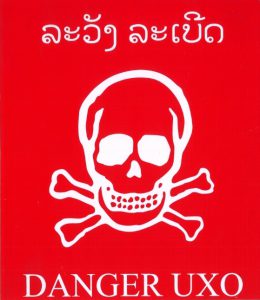ENDING THE THREAT OF UXO IN LAOS
The effect of unexploded ordnance (UXO) on Lao PDR has been and continues to be immense.
UNEXPLODED ORDNANCE (UXO)
The effect of unexploded ordnance (UXOs) on Lao PDR has been and continues to be immense. UXOs are ‘explosive weapons that failed to detonate when they were fired, dropped, launched or projected, and still pose a risk of exploding’. In Lao PDR, there are a range of UXOs contaminating the countryside, including large bombs, rockets, grenades, artillery munitions, mortars, landmines and cluster munitions. (Source: NRA UXO Sector Annual Report) (link to http://www.nra.gov.la/resources.html)
It has been estimated that around 50,000 people have been injured or killed in Laos as a result of UXO incidents since 1964. Roughly 30,000 of these incidents occurred during the time of the Second Indochina War/Vietnam War (up until 1973). The other 20,000 occurred in the post-conflict era (since 1973). It is estimated that more than 40% of victims in the post-conflict era are children. (Source: NRA UXO Sector Annual Report)
SOME STATISTICS TO REMEMBER:
- 270 million
Estimated number of sub-munitions (bombies) from cluster bombs dropped over Lao PDR between 1964 and 1973.
- 2 million tons
Estimated ordnance dropped on Lao PDR between 1964 and 1973
- 580 000
Estimated number of bombing missions flown over Lao PDR between 1964 and 1973
- Between 10% and 30%
Estimated failure rate of sub-munitions under ideal conditions.
- 80 million
Estimated number of sub-munitions that failed to explode.
- 1,090,228
Estimated number of unexploded sub-munitions destroyed by UXO LAO from 1996 to December 2009.
- ~40
Estimated number of new casualties from UXO incidents every year in Lao PDR
Sources: NRA Annual Report 2009/NRA Website
CLUSTER MUNITIONS
‘Bombies’, which are the bomblets or submunitions from cluster bombs are the most common cause of UXO incidents in Lao PDR. Roughly 30% of all of the patients who are provided with prostheses through COPE are UXO survivors. The human cost of UXO incidents in Lao PDR is ongoing and requires actions to both ban the future use of cluster munitions and to provide resources to rehabilitate affected people and land.
One of the most significant issues facing Lao PDR is the task of removing unexploded cluster munitions scattered throughout the landscape. Of 270 million cluster bombs dropped on the Lao PDR during the time of the Vietnam War it is estimated that up to 30% (80 million) failed to detonate and continue to pose a threat.
While a recent study conducted by UNICEF showed that there is a high level of awareness and understanding among both adults and children about the risks associated with UXO contact, many people on a daily basis continue to come into contact with UXOs and cluster munitions. In 2016 the UXO sector in Laos adopted new clearance guidelines (see video below).
[Embed video “The Solution”]
In September 2016, during his visit to Laos, U.S. President Obama announced that “The United States will double our annual funding to $90 million over the next three years to help Laos expand its work. This will help Laos expand its work to remove even more bombs, allow Laotians to farm more land, and increase support for victims.”
THE CONVENTION ON CLUSTER MUNITIONS
While avoiding lingering UXO is the unfortunate reality for many people in Lao PDR, the entering into force of the Convention on Cluster Munitions signals a hope that more resources will be provided to reduce the unacceptable risks posed and harm caused by cluster munitions in Lao PDR.
On 3rd of December 2008, 94 States signed the Convention on Cluster Munitions in Oslo, Norway. The Convention entered into force on 1st August 2010, some 6 months after the 30th government ratified the Convention. As at April 2013, 111 countries had joined the convention 80 of these are State parties. Among the signatories are several states affected by cluster munitions, including Laos.
The Convention on Cluster Munitions has four main obligations on State Parties:
- Destroy all stockpiles of cluster munitions within 8 years,
- Clear areas contaminated by cluster munitions within 10 years, and
- Provide assistance (medical care, rehabilitation and psychological support) to cluster munitions victims.
- Those in a position to do so, provide technical and financial support for other States Parties to meet their clearance and victim assistance obligations
The obligations under the Convention will hopefully assist in mobilizing more resources, which can be used to remove the ongoing threat of cluster munitions and provide essential rehabilitation services, such as those offered by COPE in Lao PDR and ensure that the ongoing use of cluster munitions throughout the world is stopped.
If you would like to know more about the campaign to ban cluster bombs and to see the latest information about who has and who hasn’t signed the Convention go to the Cluster Munitions Coalition (CMC) website.

